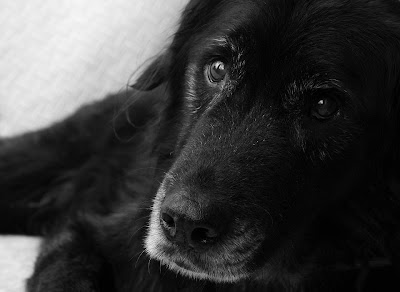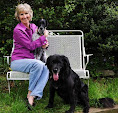Today would have been Tango’s 14th birthday. I’d
hoped to be celebrating; instead, I’m mourning his passing three weeks ago and reflecting
on his life with us.
That life began when my husband and I adopted Tango and his
sister Samba in August of 1999 at the age of 14 weeks…just one week after the
passing of our beloved dog Boris. I remember sitting with Tango on my lap at the adoption show
where we met them and thinking what a calm, quiet puppy he was; he hardly moved
at all, even though a dog sitting next to me was chewing on Tango's tail. Wow,
I thought, this is going to be one easy-going dog. I was wrong.
Our first clue that Tango had "issues" came several days after he and Samba came home with us. Both puppies were sitting in our TV room with me when my husband walked into the doorway from a dark hallway. Tango jumped up and began barking like a banshee at Mark, and it took several minutes to calm him down. Needless to say, we were startled, never having seen such a reaction in a puppy before.
We soon discovered that Tango was also startled and frightened by Kramer on Seinfeld (okay, I can understand that), the sound of the dishwasher, the automatic ice maker in the refrigerator, umbrellas being opened, unfamiliar people, and even familiar people wearing items of clothing that changed their appearance. He also was terrified of Mark's black briefcase and large black plastic garbage bags. I remember being mortified and embarrassed when Tango backed away, barking, from neighbors during walks. It was like his nerves were perpetually raw, that the world was a frightening place where potential danger lurked around every corner.
I knew we needed help so I asked our vet if he knew of any
canine behaviorists in Maryland. He didn’t but he suggested that we enroll
Tango in obedience classes, which we did. And Tango excelled in class, although he was obviously uncomfortable in the unfamiliar
surroundings. He "graduated" from beginning class and moved on to intermediate,
where he easily did three-minute "sit-stays" and one-minute
"down-stays" with me across the room. The only thing he would not
(probably could not is more accurate, given his emotional/psychological
make-up) do is "stand for examination," which involves
someone—usually, but not always, the teacher—placing a hand on the dog's head
and running it down the dog's shoulders and rump. Tango eventually would let
our female instructor touch him, but any time she asked a man to assist in the
exercise, Tango would back away.
We eventually stopped going to class because around the age of two or three years Tango began displaying dog-aggression tendencies. He would almost always ignore the dogs around him but if one of them broke a sit-stay and came bouncing over, Tango seemed to feel threatened and would respond aggressively. I did my best to keep Tango focused on me and asked other handlers not to let their dogs get in Tango's face. Unfortunately, some people just didn't get it. One older woman with a little Yorkie-type dog would let her dog jump at Tango's face. I told her that Tango didn't like that, and her response was that her dog was just being friendly. I'd explain over and over again that Tango didn't see it that way. Eventually, it just got too stressful.
Over the years, I increased my knowledge of dog behavior issues in an effort to better understand my troubled boy. I read such books as Bones Would Rain from the Sky: Deepening Relationships with Dogs by Suzanne Clothier; Cautious Canine, Feisty Fido: Help for the Leash Aggressive Dog, and The Other End of the Leash by Patricia McConnell; The Dog Who Loved Too Much by Nicholas Dodman; and Aggression in Dogs: Practical Management, Prevention & Behavior Modification by Brenda Aloff. I attended seminars by Patricia McConnell and Sarah Kalnajs, and worked with a local behaviorist/trainer. And I began putting the knowledge I acquired into action with Tango.
The good news is that it did help. Although Tango never became comfortable enough with new human acquaintances or accepting of other new dogs to go to dog parks or for "play dates" with our friends' dogs or to attend "yappy hours" or other "dog friendly" events, I was able to take him for walks without him lunging, barking, and growling at other dogs we passed. Thanks to patient, consistent, positive training—and some really yummy treats—I could turn his attention back to me. In fact, when we passed a neighbor's house and their three dogs ran along the fence and barked at Tango, he would automatically look up at me instead of them. He also became more trusting of new visitors to our home...especially if they were willing to throw a ball instead of trying to pet him. Basically, he became more comfortable in his own skin.
Thanks to Tango, I learned more about dog behavior than I could ever have imagined...information that has benefited not only me but also other people who have sought my input on their own dog challenges. And I have met some amazing people who I never would have met otherwise...people who have enriched my life in many ways. And, most importantly, I had the privilege of seeing Tango mature and develop into a wonderful, if flawed, companion. My mother once said, "It's not easy being Tango." I honestly believe, however, that thanks to the love that we showed him and the work we engaged in together, that "being Tango" grew progressively easier over time.
Interestingly, during the last year or so of his life, as
his physical faculties—eyesight, hearing, and mobility—deteriorated, Tango's emotional/psychological stability seemed to grow stronger. For the first time
in his life, he actively sought out physical contact and affection…perhaps as a
way of reaffirming his connection with us and his place in the world around
him.
Nevertheless, his decline was painful to witness. For most
of his life, playing fetch was Tango’s greatest joy…one might even say an
obsession. My husband can still recall once tossing the ball to Tango from our
bed 125 times in a row. But as arthritis caused increasing pain and degenerative myelopathy
reduced his control over his hind legs, Tango’s interest in retrieving dwindled.
For many months, however, he continued to carry his ball around the house with
him and would drop it in the tub when I was taking a bath, sticking his muzzle
in the water to retrieve it.
But eventually even this behavior ended. Once in a great while
Tango would pick up a ball and carry it briefly as if trying to
recapture some fleeting moment from his youth, then drop it as if he couldn’t
remember why he was carrying it. It was as if this special connection between
dog and ball paralleled a larger “disconnecting” from life in general…a slowly
letting go that broke my heart to see.
In some ways, Tango’s passing hit me harder than that of
previous canine companions…perhaps because he required so much work and
“management.” The bond I developed with him over nearly 14 years was incredibly strong, and the sense of loss I feel now is equally powerful.
As I adjust to a life that will undoubtedly be easier, but
far emptier, I can only hope that my beautiful, troubled boy has found true peace at last.






